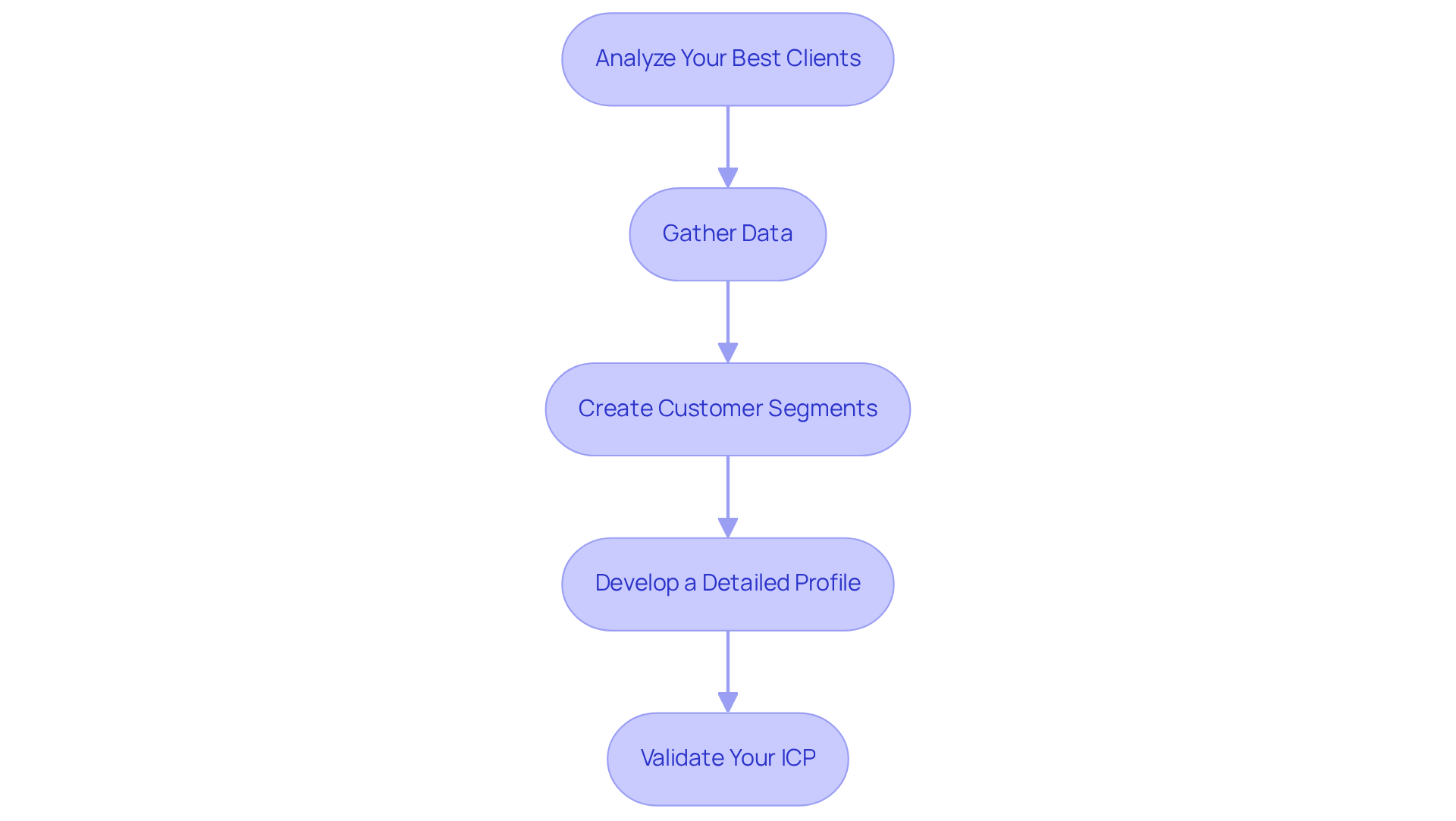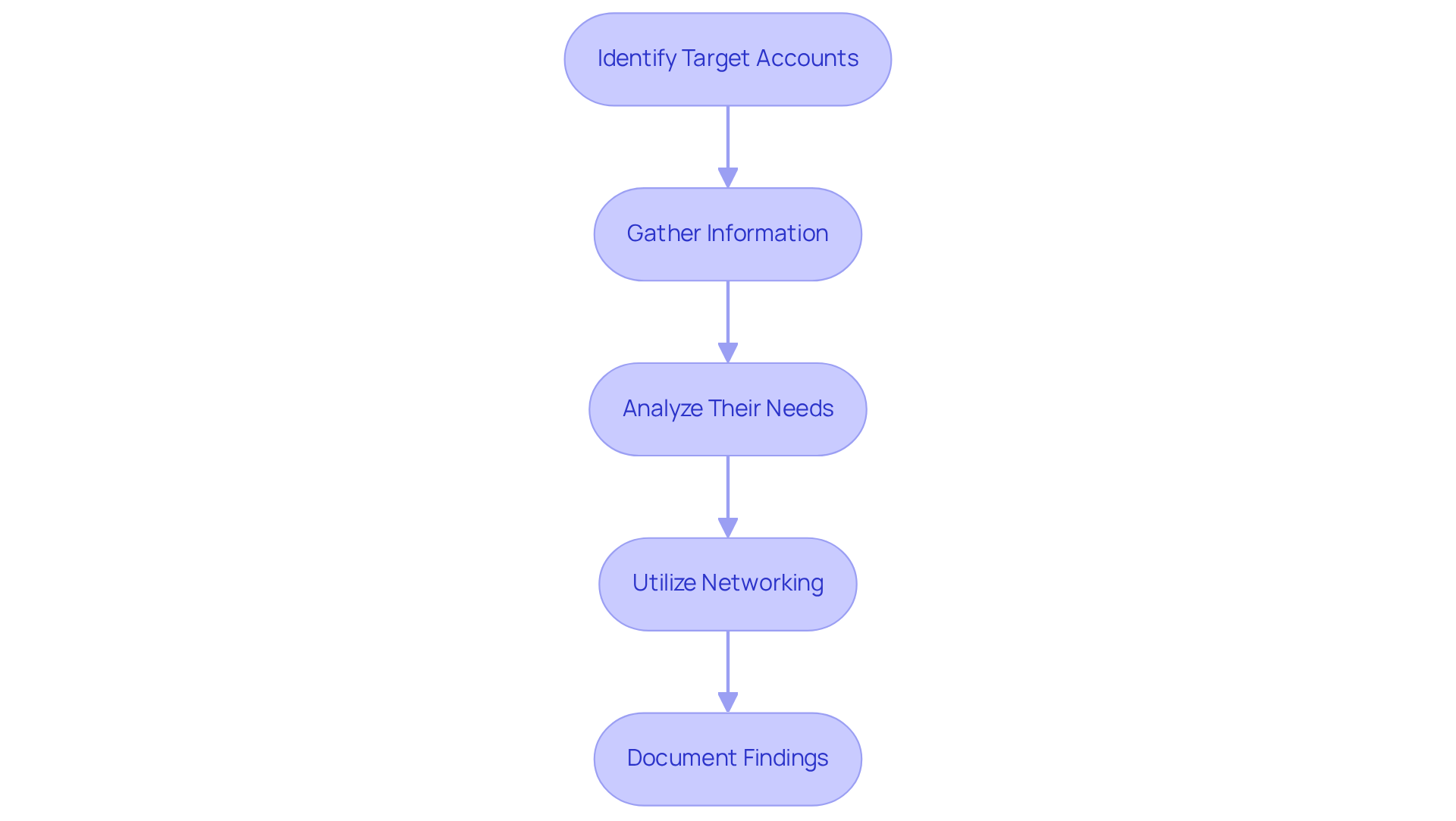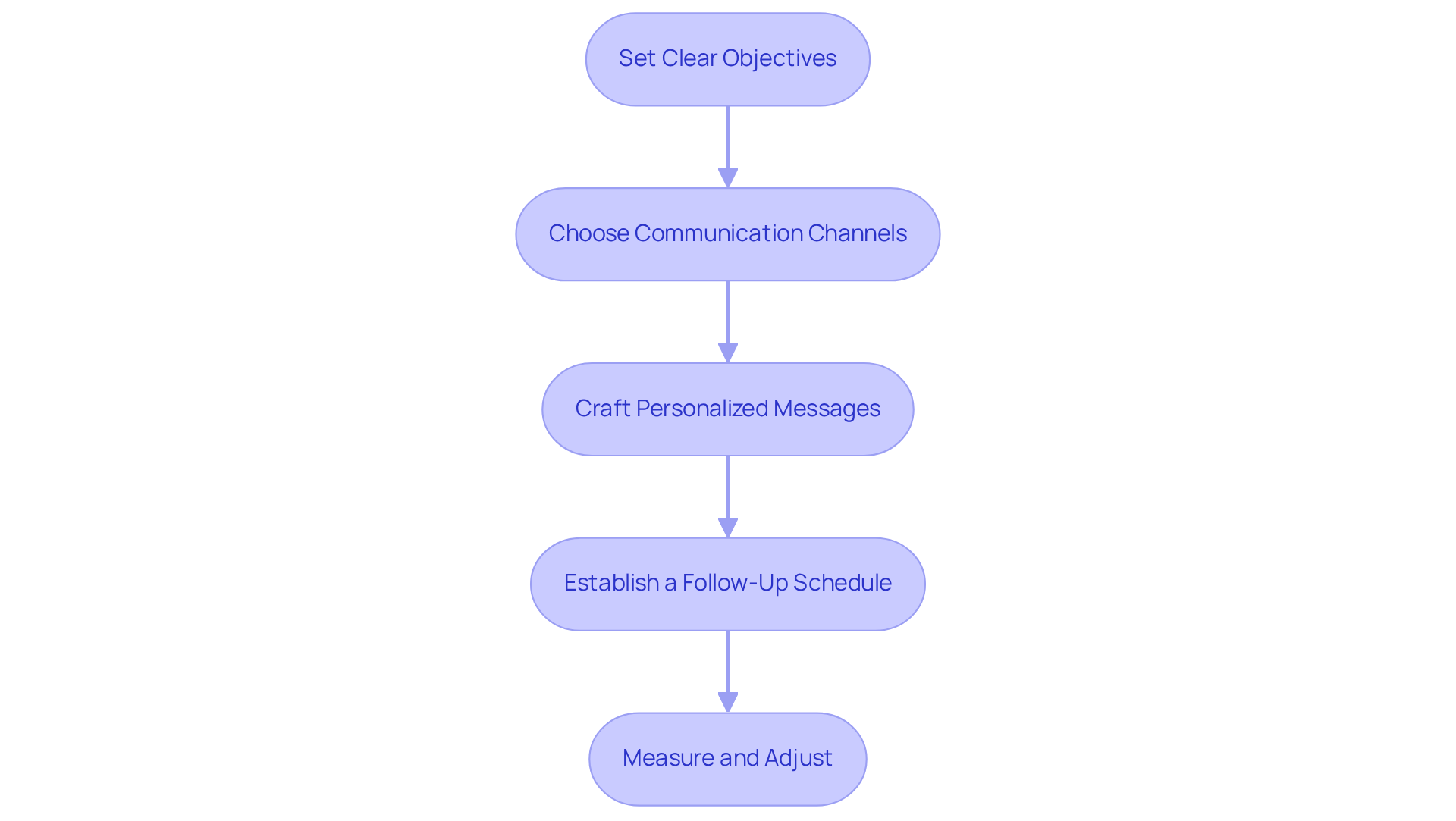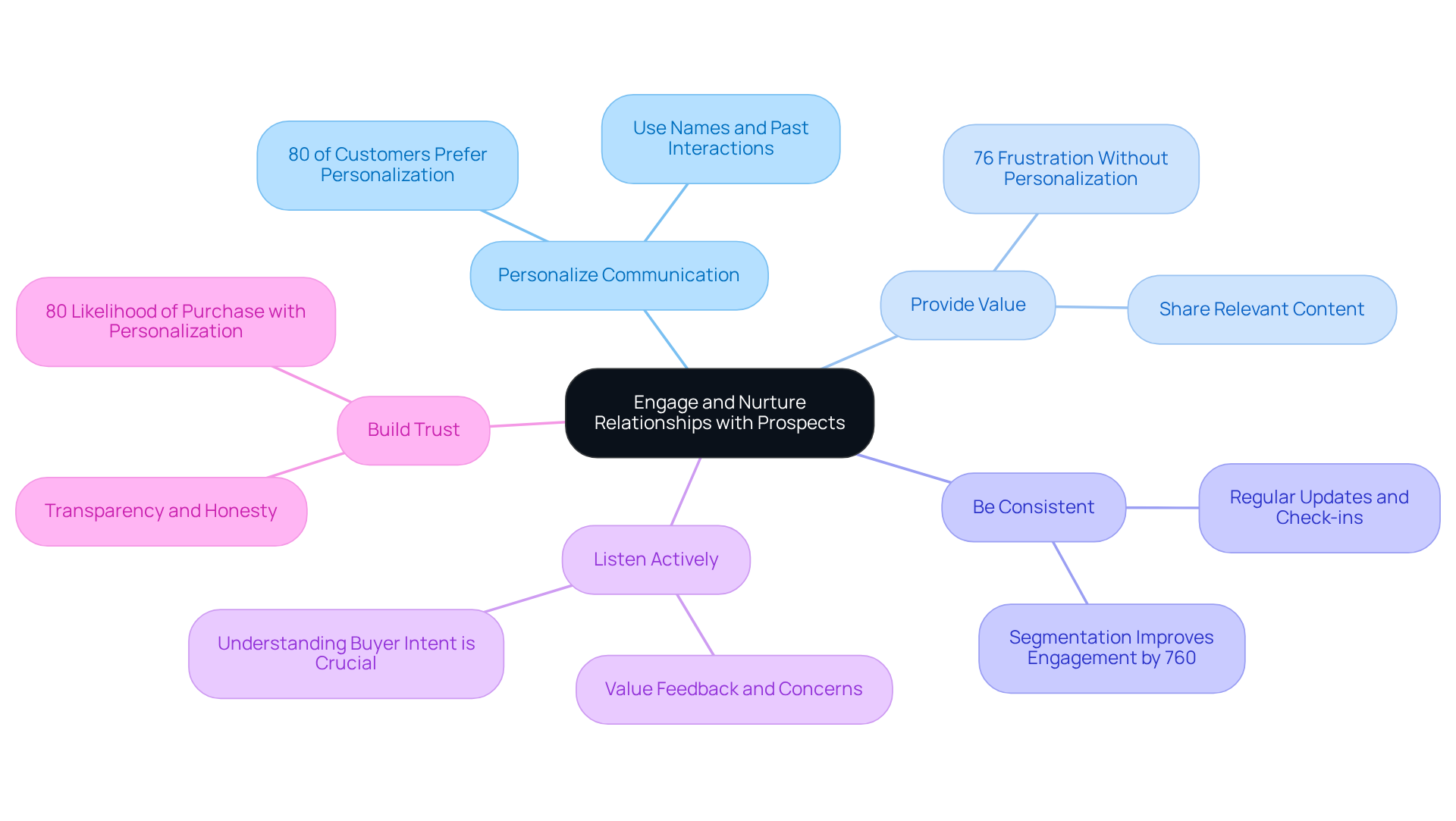Overview
This article presents a thoughtful approach for small businesses to confidently master qualified accounts. By defining ideal customer profiles, researching potential accounts, developing targeted outreach plans, and engaging prospects effectively, you can lay a solid foundation for success. We understand your challenges, and by emphasizing the importance of personalization, data-driven strategies, and consistent communication, we aim to support you in enhancing your marketing efforts.
Imagine how meaningful relationships can transform your business. As you implement these steps, you'll likely see improved conversion rates and overall business success. Together, we can achieve this by focusing on strategies that resonate with your unique circumstances. Remember, fostering these connections is not just about numbers; it’s about creating lasting partnerships that benefit both you and your customers.
Take a moment to reflect: How can you personalize your outreach to make it more impactful? By incorporating these insights into your strategy, you're not just enhancing your marketing efforts; you're building a nurturing environment for your prospects. Let's embark on this journey together, ensuring that your approach is both compassionate and effective.
Introduction
Mastering the art of qualified accounts is not just a strategy; it’s a vital step for small businesses aiming for sustainable growth and success. By focusing on the ideal customer profile, you can tailor your marketing strategies to attract clients who truly resonate with your offerings and contribute to your long-term profitability.
Yet, we understand the challenge of identifying and engaging these potential accounts amidst fierce competition and ever-changing market demands. How can you navigate this complex landscape and ensure that your outreach efforts foster meaningful connections?
Together, we can explore solutions that empower your business to thrive.
Define Your Ideal Customer Profile
To define your ideal customer profile, let’s walk through these essential steps together:
- Analyze Your Best Clients: Start by identifying your top clients. What common characteristics do they share? Consider aspects like industry, company size, revenue, and location. This foundational analysis helps uncover the traits that contribute to their success with your business.
- Gather Data: Take the time to utilize surveys, interviews, and analytics to collect comprehensive data on your existing customers. Understanding their is crucial for tailoring your approach. Remember, according to the SBA, 42% of businesses that close within the first five years do so due to insufficient market demand. This highlights the importance of this step.
- Create Customer Segments: Group your customers into segments based on shared traits. This could include demographics, buying behavior, or engagement levels. Effective segmentation strategies can lead to more focused marketing initiatives, which are vital for the growth of small businesses like yours.
- Develop a Detailed Profile: For each segment, create a detailed profile that outlines their challenges, goals, and how your product or service can address their specific needs. This clarity will guide your messaging and outreach efforts. As Liam Austin, co-founder of Entrepreneurs HQ, wisely states, 'Success among small enterprises doesn’t happen by chance.' It comes from having the right offer, attracting the right clients, and building a business that works for you.
- Validate Your ICP: Test your ideal client profile by reaching out to similar prospects and evaluating the outcomes. Adjust your profile based on feedback and performance metrics to ensure it accurately reflects your target audience. Companies that effectively analyze their clients can significantly enhance their marketing efforts and improve conversion rates.
By following these steps, you will create a clear picture of who your ideal clients are, which will inform your outreach strategies moving forward. This process is essential, as it not only helps in understanding your market but also mitigates the risks associated with insufficient market demand. Together, we can achieve success by truly understanding and addressing the needs of your ideal customers.

Research Potential Accounts and Their Needs
To effectively research potential accounts, let's follow these thoughtful steps together:
- Identify Target Accounts: Begin by utilizing your Ideal Client Profile (ICP) to create a list of potential accounts that align with your vision. Tools like LinkedIn Sales Navigator or industry databases can be invaluable in this process.
- Gather Information: Take the time to research each account, exploring their business model, industry trends, and recent news. Look for insights into their challenges and aspirations, as understanding these elements will help you connect on a deeper level.
- Analyze Their Needs: Delve into specific pain points that your product or service can alleviate. This might involve reading industry reports, customer reviews, or engaging with their content on social media. Remember, the more you understand their needs, the better you can serve them.
- Utilize Networking: Leverage your to gain insights about potential accounts. Attending industry events or webinars can be a great way to connect with key decision-makers and gather valuable information.
- Document Findings: Create a detailed report for each account, summarizing your research and insights. This will not only serve as a reference for your engagement efforts but also empower you to approach each potential account with confidence and clarity.
By conducting thorough research, you will be better equipped to customize your engagement strategies, ensuring they meet the unique needs of each qualified account. Together, we can navigate this journey and achieve success.

Develop Targeted Outreach Plans
To develop targeted outreach plans that truly resonate, consider these thoughtful steps:
- Set Clear Objectives: Begin by specifying what you hope to achieve with your engagement activities. With the support of Wayy.ai, you can identify to focus on, such as lead generation or brand awareness—ensuring your goals align with your vision.
- Choose Communication Channels: Reflect on the best channels to connect with your target accounts. This may include email, social media, phone calls, or even direct mail—each channel offers unique opportunities to engage meaningfully.
- Craft Personalized Messages: Take the time to create tailored messages for each account based on your research. Highlight how your product or service addresses their specific needs and challenges, using insights from Wayy.ai to inform your approach. This personalized touch shows that you genuinely care.
- Establish a Follow-Up Schedule: Plan a thoughtful sequence of follow-ups to maintain engagement. This could involve sending additional resources, checking in after a meeting, or sharing relevant content—each step reinforces your commitment to their success.
- Measure and Adjust: Regularly monitor the effectiveness of your engagement efforts using metrics such as open rates, response rates, and conversion rates. With Wayy.ai, you can receive daily email updates that provide key insights into how many leads were reached, who showed interest, and how your conversion rate is improving. Use this information to refine your strategy and enhance future engagement plans—together, we can achieve success.
By following these caring steps, you will create a focused engagement plan that significantly enhances your chances of connecting with potential clients, fostering meaningful relationships along the way.

Engage and Nurture Relationships with Prospects
To effectively engage and nurture relationships with prospects, consider these compassionate strategies:
- Personalize Communication: Tailor your interactions to reflect the prospect's preferences and previous conversations. Using their name and referencing past discussions adds a personal touch that fosters connection. Did you know that 80% of customers are more likely to purchase from brands that offer personalized experiences? This approach is crucial for building rapport.
- Provide Value: Share insightful content that aligns with their needs and interests. This could include blog posts, case studies, or industry insights that showcase your expertise and understanding of their challenges. Remember, 76% of consumers feel frustrated when brands do not deliver personalization. This highlights the importance of relevant communication.
- Be Consistent: Regular communication through newsletters, updates, or check-ins keeps your brand at the forefront of their minds. Consistency is key to maintaining engagement and building familiarity. Additionally, did you know that segmentation can improve email engagement by 760%? This makes your outreach efforts even more effective.
- Listen Actively: Show genuine interest in your prospects' feedback and concerns. Respond thoughtfully to their input, demonstrating that you value their opinions and are willing to adapt your approach accordingly. is crucial for winning their business, as it allows you to tailor your strategies effectively.
- Build Trust: Establish credibility by being transparent and honest in your communications. Sharing testimonials, success stories, and relevant data reinforces your value proposition and helps to build a trustworthy relationship. As Cassidy Horton highlights, "80% of consumers are more likely to buy from brands that offer personalized experiences." This underscores the significance of personalization in maintaining clientele.
Engaging and nurturing relationships with prospects lays a strong foundation for converting leads into loyal customers. Remember, personalized communication is not just a strategy; it is essential for fostering long-term connections that drive sales success. Together, we can achieve meaningful engagement that resonates with your audience.

Conclusion
Mastering the art of qualified accounts is vital for small businesses striving for sustainable growth and success. By understanding your ideal customer profile, conducting thorough research, and developing targeted outreach strategies, you can connect with the right clients and nurture meaningful relationships. This comprehensive approach not only helps mitigate risks associated with market demand but also lays a solid foundation for long-term success.
In this article, we have outlined key steps to guide you on this journey. From analyzing your existing customers to creating detailed profiles, and from researching potential accounts to nurturing relationships, each stage is crucial in building a focused marketing strategy. Emphasizing personalization and consistent engagement is essential, as these elements significantly enhance the likelihood of converting leads into loyal customers.
Ultimately, the importance of mastering qualified accounts cannot be overstated. By implementing these strategies, you can effectively address the unique needs of your target market, ensuring that you stand out in a competitive landscape. Embracing this process not only drives sales success but also cultivates lasting connections that will benefit your business for years to come. Together, we can navigate these challenges and achieve the success you envision.
Frequently Asked Questions
What is the first step in defining your ideal customer profile?
The first step is to analyze your best clients by identifying the common characteristics they share, such as industry, company size, revenue, and location.
How can I gather data on my existing customers?
You can gather data through surveys, interviews, and analytics to understand your customers' pain points, needs, and how they discovered your services.
Why is segmenting customers important?
Segmenting customers into groups based on shared traits allows for more focused marketing initiatives, which are vital for the growth of small businesses.
What should a detailed customer profile include?
A detailed customer profile should outline the segment's challenges, goals, and how your product or service can address their specific needs.
How can I validate my ideal customer profile?
You can validate your ideal customer profile by reaching out to similar prospects and evaluating the outcomes, adjusting your profile based on feedback and performance metrics.
What is the significance of understanding your ideal customer?
Understanding your ideal customer helps inform your outreach strategies, enhances marketing efforts, improves conversion rates, and mitigates risks associated with insufficient market demand.




